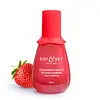What's inside
What's inside
 Key Ingredients
Key Ingredients

 Benefits
Benefits

 Concerns
Concerns

 Ingredients Side-by-side
Ingredients Side-by-side

Water
Skin ConditioningNiacinamide 10%
SmoothingOryza Sativa Extract
AbsorbentIsodecyl Neopentanoate
EmollientSqualane 5%
EmollientSorbitol
HumectantPentylene Glycol
Skin ConditioningHydrogenated Polyisobutene
EmollientRice Ferment Filtrate
Skin ConditioningButylene Glycol
HumectantRosa Damascena Flower Water
MaskingCaffeine 1%
Skin ConditioningGlycyrrhiza Glabra Root Extract
BleachingGlycerin
HumectantAcrylates Copolymer
Vp/Polycarbamyl Polyglycol Ester
Hydrolyzed Sesame Protein Pg-Propyl Methylsilanediol
Skin ConditioningBenzyl Alcohol
PerfumingHydroxyacetophenone
AntioxidantCaprylyl Glycol
EmollientEthylhexyl Olivate
Skin ConditioningSodium Acrylates Copolymer
Polyglyceryl-4 Olivate
EmollientCyclodextrin
AbsorbentSodium Hyaluronate
HumectantTocopheryl Acetate
AntioxidantSodium Gluconate
Skin ConditioningWater, Niacinamide 10%, Oryza Sativa Extract, Isodecyl Neopentanoate, Squalane 5%, Sorbitol, Pentylene Glycol, Hydrogenated Polyisobutene, Rice Ferment Filtrate, Butylene Glycol, Rosa Damascena Flower Water, Caffeine 1%, Glycyrrhiza Glabra Root Extract, Glycerin, Acrylates Copolymer, Vp/Polycarbamyl Polyglycol Ester, Hydrolyzed Sesame Protein Pg-Propyl Methylsilanediol, Benzyl Alcohol, Hydroxyacetophenone, Caprylyl Glycol, Ethylhexyl Olivate, Sodium Acrylates Copolymer, Polyglyceryl-4 Olivate, Cyclodextrin, Sodium Hyaluronate, Tocopheryl Acetate, Sodium Gluconate
Water
Skin ConditioningNiacinamide
SmoothingPropanediol
SolventPhenyl Trimethicone
Skin ConditioningIsohexadecane
EmollientHamamelis Virginiana Leaf Extract
Skin ConditioningPropylene Glycol
HumectantSodium Benzoate
MaskingPhenoxyethanol
PreservativeEthylhexylglycerin
Skin ConditioningSorbitol
HumectantDimethicone
EmollientFragaria Ananassa Fruit Extract
Skin ConditioningCyanocobalamin
Skin ConditioningSodium Hyaluronate
HumectantXylitylglucoside
HumectantAnhydroxylitol
HumectantXylitol
HumectantTrehalose
HumectantTocopheryl Acetate
AntioxidantPhragmites Communis Extract
Skin ConditioningPoria Cocos Extract
Skin ConditioningBetaine
HumectantSodium PCA
HumectantSodium Lactate
BufferingPCA
HumectantSerine
MaskingAlanine
MaskingGlycine
BufferingGlutamic Acid
HumectantLysine Hcl
Skin ConditioningThreonine
Arginine
MaskingProline
Skin ConditioningAllantoin
Skin ConditioningCetearyl Olivate
Sorbitan Olivate
EmulsifyingPolymethyl Methacrylate
Polyacrylate Crosspolymer-6
Emulsion StabilisingPolymethylsilsesquioxane
Xanthan Gum
EmulsifyingDisodium EDTA
Water, Niacinamide, Propanediol, Phenyl Trimethicone, Isohexadecane, Hamamelis Virginiana Leaf Extract, Propylene Glycol, Sodium Benzoate, Phenoxyethanol, Ethylhexylglycerin, Sorbitol, Dimethicone, Fragaria Ananassa Fruit Extract, Cyanocobalamin, Sodium Hyaluronate, Xylitylglucoside, Anhydroxylitol, Xylitol, Trehalose, Tocopheryl Acetate, Phragmites Communis Extract, Poria Cocos Extract, Betaine, Sodium PCA, Sodium Lactate, PCA, Serine, Alanine, Glycine, Glutamic Acid, Lysine Hcl, Threonine, Arginine, Proline, Allantoin, Cetearyl Olivate, Sorbitan Olivate, Polymethyl Methacrylate, Polyacrylate Crosspolymer-6, Polymethylsilsesquioxane, Xanthan Gum, Disodium EDTA
 Reviews
Reviews

Ingredients Explained
These ingredients are found in both products.
Ingredients higher up in an ingredient list are typically present in a larger amount.
Niacinamide is a multitasking form of vitamin B3 that strengthens the skin barrier, reduces pores and dark spots, regulates oil, and improves signs of aging.
And the best part? It's gentle and well-tolerated by most skin types, including sensitive and reactive skin.
You might have heard of "niacin flush", or the reddening of skin that causes itchiness. Niacinamide has not been found to cause this.
In very rare cases, some individuals may not be able to tolerate niacinamide at all or experience an allergic reaction to it.
If you are experiencing flaking, irritation, and dryness with this ingredient, be sure to double check all your products as this ingredient can be found in all categories of skincare.
When incorporating niacinamide into your routine, look out for concentration amounts. Typically, 5% niacinamide provides benefits such as fading dark spots. However, if you have sensitive skin, it is better to begin with a smaller concentration.
When you apply niacinamide to your skin, your body converts it into nicotinamide adenine dinucleotide (NAD). NAD is an essential coenzyme that is already found in your cells as "fuel" and powers countless biological processes.
In your skin, NAD helps repair cell damage, produce new healthy cells, support collagen production, strengthen the skin barrier, and fight environmental stressors (like UV and pollution).
Our natural NAD levels start to decline with age, leading to slower skin repair, visible aging, and a weaker skin barrier. By providing your skin niacinamide, you're recharging your skin's NAD levels. This leads to stronger, healthier, and younger looking skin.
Another name for vitamin B3 is nicotinamide. This vitamin is water-soluble and our bodies don't store it. We obtain Vitamin B3 from either food or skincare. Meat, fish, wheat, yeast, and leafy greens contain vitamin B3.
The type of niacinamide used in skincare is synthetically created.
Learn more about NiacinamideSodium Hyaluronate is hyaluronic acid's salt form. It is commonly derived from the sodium salt of hyaluronic acid.
Like hyaluronic acid, it is great at holding water and acts as a humectant. This makes it a great skin hydrating ingredient.
Sodium Hyaluronate is naturally occurring in our bodies and is mostly found in eye fluid and joints.
These are some other common types of Hyaluronic Acid:
Learn more about Sodium HyaluronateSorbitol is a sugar alcohol. It is a hydrating and moisturizing agent created from the reduction process of glucose.
Most sorbitol is usually made from potato starch. It is also found in fruits such as apples and pears.
As a humectant, Sorbitol helps draw water to the skin. This helps keep the skin hydrated. Sorbitol also helps create a thicker texture in products. You might find sorbitol in your toothpaste and other gels.
It is a non-irritating ingredient that is great for those with dry skin.
Sorbitol is a prebiotic. It helps promote the growth of healthy bacteria on your skin. The bacteria on your skin form a microbiome. This microbiome helps protect your skin from infection and harmful bacteria.
Learn more about SorbitolTocopheryl Acetate is AKA Vitamin E. It is an antioxidant and protects your skin from free radicals. Free radicals damage the skin by breaking down collagen.
One study found using Tocopheryl Acetate with Vitamin C decreased the number of sunburned cells.
Tocopheryl Acetate is commonly found in both skincare and dietary supplements.
Learn more about Tocopheryl AcetateWater. It's the most common cosmetic ingredient of all. You'll usually see it at the top of ingredient lists, meaning that it makes up the largest part of the product.
So why is it so popular? Water most often acts as a solvent - this means that it helps dissolve other ingredients into the formulation.
You'll also recognize water as that liquid we all need to stay alive. If you see this, drink a glass of water. Stay hydrated!
Learn more about Water